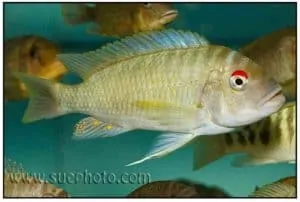Chindongo flavus
Chindongo flavus was described in 1988 by Jay R. Stauffer Jr. based on the holotype that was caught off the Chinyoukwazi island in 1984. For a long time, this species was known under the synonym Pseudotropheus flavus.
The name flavus is derived from Latin and means yellow in reference to the color of this Malawi cichlid.
Description
The Chindongo elongatus group is characterized by its elongated, slender shape, as is the Chindongo flavus. The males can grow to about 12 centimeters in length in the aquarium, the females remain slightly smaller at 10 centimeters. In the wild, both remain slightly smaller.
The males are the most beautifully colored. They have a golden yellow color on their flanks between six black vertical stripes. The yellow-black stripes continue on the top of their heads. The head is otherwise black. There is often a green iridescent surface on the gill cover. The dorsal fin is black on the top, edged with a yellow-gold stripe. The pelvic fins are black, trimmed at the front edge with a blue edge. The anal fin is black and often has one egg spot. The caudal fin is black with yellow membranes. The females are less intensely colored than the males and tend to be more brownish than black.
The male is territorial, especially towards other males of his species. Be aware that he will act aggressively towards other males who look similar!
Biotope
This Malawi cichlid can only be found on the small island of Chinyoukwezi which is located in the south of Lake Malawi, in the middle of the water north of Cape Mac Clear. They were caught there between 7.5 and 18 meters in depth. They are most common at depths of 8 to 15 meters but have also been seen at depths of 35 meters.
Chindongo flavus does not occur in shallower water than 7.5 meters. It is suspected that this is due to their golden-yellow color which stands out in shallower water and exposes them to attacks by surface inhabitants.
Diet
In the wild, they feed on algae and plankton. In the aquarium, the food should largely consist of vegetable material such as spirulina flakes. You can alternate this with mysis, krill, brine shrimp, finely chopped shrimp, etc. Never give them red mosquito or tubifex. This can certainly lead to Malawi Bloat disease in the herbivorous Mbuna.
The Aquarium
Chindongo flavus prefers sand on the bottom, but the rocks are even more important. Make sure there are more than enough of them. The females can seek shelter between the rocks and the males make their territory. Allow the rocks to grow well with a layer of algae. The fish comb these algae in search of something to eat.
Plants are not often used. Soft leaves are eaten, so the plant doesn’t stand a chance. If you do want to use plants, use plant species with tough leaves such as Vallisneria or Java fern.
The aquarium itself must have a minimum length of about 120 centimeters with a volume of about 250 litres.
Breeding aquarium and conditioning
Breeding Chindongo flavus is usually not a problem. Not even in an aquarium with other Malawi cichlids. Preferably, the aquarium is set up with sand on the bottom.
Make sure there are no similar Chindongos to avoid hybridization.
The spawn
The male chooses the spawning spot. Usually, this is next to a large rock in the sand. Here he digs a shallow pit of about 10 centimeters in diameter. The male flares his fins, shows his most beautiful colors, and tries to lure the female with trembling movements. The female is all set as soon as you can see her laying tube.
They keep going circling each other. The female lays some eggs in the sand while they keep circling each other. The male rubs his anal fin on the sand, seducing the female to pick up the egg spots on his anal fin. When she does, he releases some sperm fertilizing the eggs in her mouth. While circling, she also picks up the real eggs.
Usually, the nests contain about 10 to 30 eggs. The size of the nest depends on the size and experience of the female.
Raising the fry
The eggs of Chindongo flavus are incubated by the female in her mouth. After about 18 days they are small fish and the female will spit them out. You can feed the fry with crushed flakes or very fine dry food. Keep in mind that these are herbivores, so don’t feed them too much/often brine shrimp and other meat-like food. Instead, choose spirulina, for example.
If you want to raise the whole nest, you can catch the female after about 14 days and place her in a separate aquarium. Provide some shelter in the form of a few stacked rocks. After spitting out the fry, the female will not eat them immediately. You then have about 1 to 1.5 days to place the female back in your show aquarium.
Conclusion
Chindongo flavus is a very attractively colored Malawi cichlid. With the right tankmates and decoration, it will really be an eye-catcher in the aquarium. Given its diet, it is best to combine this species with other rock dwellers from Lake Malawi, the Mbuna. Be careful not to keep it together with similarly colored and marked species.
Video
Author
John de Lange
Copyright images
Jason Selong – Bigskycichlids.com
John de Lange
Literature
Three New Rock-Dwelling Cichlids from Lake Malawi, Africa 1988 JAY R. STAUFFER, JR. –
Malawifreaks.nl (original website no longer available)
Cichlidworld.eu (original website no longer available)















Reviews
There are no reviews yet.